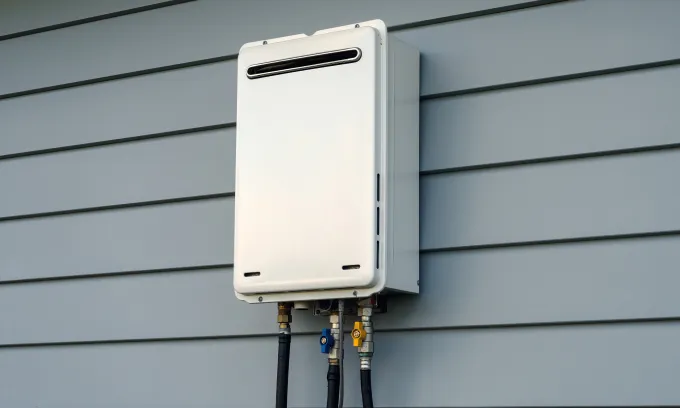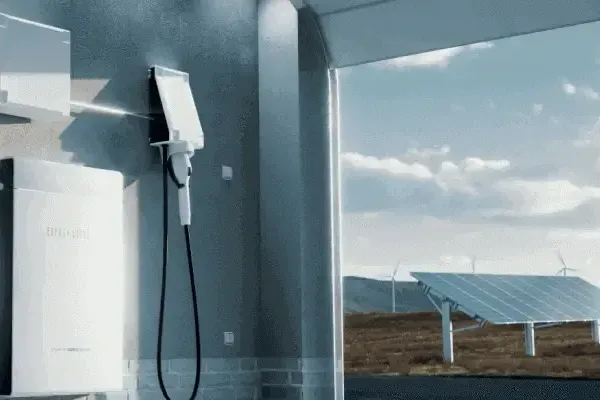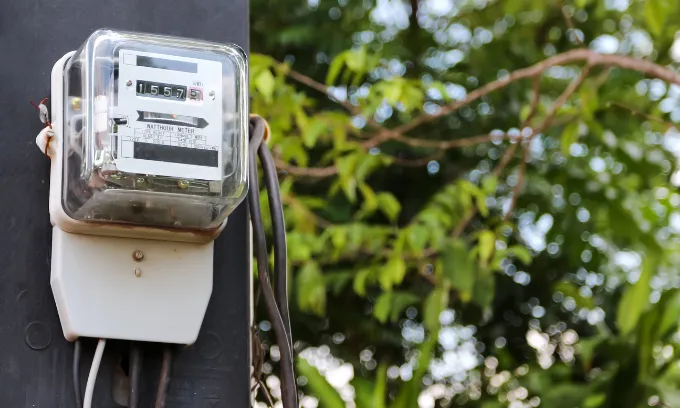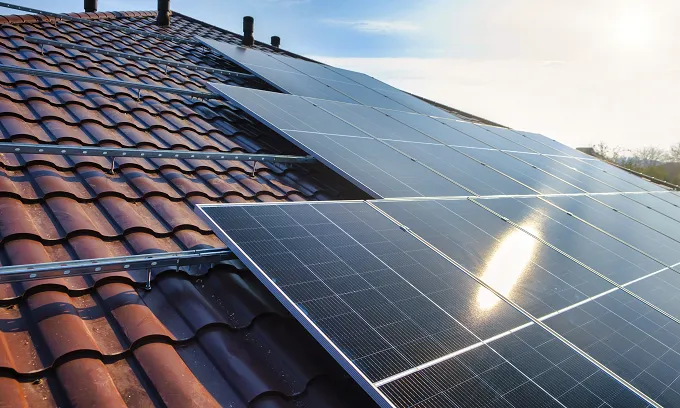What is a hot water system?
A hot water system uses energy to heat water. They can be powered by electricity, gas or solar.
To enjoy running hot water, your washing machine, sinks and showers must be connected to your hot water system.
Why are hot water systems important?
Hot water systems contribute to around 29% of your energy bill, according to NSW Climate and Action.
Picking an appropriately-sized and energy-efficient hot water system can help save you a significant amount of money.
However, how much you save will depend on the time it takes for your system’s savings to cover its purchase and installation.
Types of hot water systems
There are four main types of hot water systems available with electricity, gas, or solar-powered systems.
There are three types of hot water systems available with electricity, gas or solar-powered systems.
Storage hot water system
Storage hot water systems consist of an insulated tank where water is continuously heated by a copper or nickel-chrome element (for electric and solar) or a pilot light (for gas).
As hot water is used, cold water will replenish the storage tank and wait to be heated during the next cycle. They can either be installed indoors or outdoors.
Storage hot water system pros and cons
Pros:
- Undisturbed use: Can supply hot water to multiple outlets without losing hot water from any single one.
- Affordable: Generally cost the least to purchase and install.
- Cost-friendly maintenance: Inexpensive to maintain or repair.
Cons:
- Loss of heat: Storage tanks are susceptible to heat loss.
- Higher usage costs: Typically have the most expensive running costs.
- Bulky: Depending on the size of the storage tank, storage systems require a large amount of space.
- Wear and tear: May experience corrosion and rust.
Storage hot water system size
Storage hot water systems come in sizes as small as 80 litres (L) and as large as 400L. Larger storage systems will consume more electricity, gas or solar to maintain a larger body of hot water. They also cost more to purchase and install.
That’s why it is crucial to correctly size a tank to match your hot water needs.
The size of your storage hot water system will depend on the number of people living in your home and their usage habits.
Number of people | Size of storage hot water system |
1 - 3 | 80l - 125L |
2 - 4 | 125l - 160L |
3 - 6 | 160l - 315L |
5 - 8 | 250l - 400L |
Continuous flow hot water system
A continuous flow system, also known as instantaneous, on demand or tankless hot water systems, heats the water as you use it rather than maintaining a stored, heated supply.
- When a hot water tap is switched on, a flow sensor detects the water movement and activates the heating element.
- As the cold water flows through the heat exchanger, it is heated instantly and sent to the tap.
The heat exchanger in continuous flow hot water systems is typically powered by either gas or electricity. Solar continuous flow systems exist, but they are very expensive and are usually reserved for commercial applications.
Continuous flow hot water system pros and cons
Pros:
- Constant hot water access: As water is heated on demand, you won’t need to worry about running out of hot water for the day.
- Energy-efficient: More energy-efficient than traditional systems because it doesn’t have to maintain stored water at the correct temperature.
- Lower usage costs: Have lower running costs than storage hot water systems.
- Long lifespan: Generally lasts more than 20 years, which is around twice as long as a storage system.
- Space-friendly: Usually comprise a smaller, wall-mounted unit, taking up less room than storage hot water systems with tanks.
- Ease of maintenance: Typically require less maintenance and repairs than storage hot water systems.
Cons:
- Longer waiting time: Water takes a little longer to heat up than a storage tank, where it’s readily available.
- Higher upfront costs: More expensive to purchase and install.
- Inconsistent temperatures: Temperatures can fluctuate when hot water demand changes drastically.
- Unable to store hot water.
Continuous flow hot water system size
Because hot water isn’t stored, continuous flow hot water systems are sized based on the number of hot water outlets.
An undersized system will struggle to supply hot water to multiple taps or showerheads at once, especially during peak periods.
It’s important to consider how many faucets or showers you need to supply hot water to and the number of people living under the same roof.
Heat pump
A heat pump with storage uses refrigerants, compressors and the heat of ambient air to heat your water. Most modern heat pumps are powered by electricity and solar.
This system, unlike other solar hot water systems, draws solar heat from the air to heat water. To pump in hot air, the system draws a small amount of electricity to power its compressor.
Heat pump system pros and cons
Pros:
- Solar-ready: Most modern heat pumps are partially powered by your solar system, lowering your running electricity costs and carbon emissions.
- Energy-efficient: More energy efficient than storage hot water systems with lower running costs.
- Ground-mounted: Heat pumps do not need to be installed on the roof of your home.
Cons:
- Ineffective in cold weather: Not as effective in cooler climates, where ambient temperatures are lower.
- Higher upfront costs: Expensive to purchase and install upfront.
- Still requires electricity: Solar-powered heat pumps still require electricity to power their compressor.
- Noisy operations.
Heat pump hot water system size
Like a storage hot water system, a heat pump system is sized based on the volume of water it can heat up. The size you commit to will boil down to the size of your household:
Number of people | Size of heat pump hot water system |
1 - 2 | Less than 200L |
3 - 4 | 200l - 300L |
4 and more | 300l - 450L |
Centralised hot water systems
A centralised or bulk hot water system provides tenants living in apartment complexes and multi-dwelling homes with hot water. Tenants are then individually metered and billed.
Origin Energy is potentially the largest supplier of centralised hot water in Australia, offering bulk hot water and serviced hot water options.
Centralised hot water systems currently come in gas (which is more popular) or electric options. You should be billed separately for your gas/electricity usage and your cold water, which is handled by your water retailer.
Centralised hot water systems pros and cons
Pros
- Bulk purchasing power: Apartment blocks purchasing ‘hot water’ in bulk can deliver potential savings to each resident. However, this isn’t always guaranteed.
- Space-saving: A centralised system means that hot water can be supplied without having a storage tank in each apartment.
- Avoids water damage in your apartment: Having a centralised hot water tank makes it easier to address any leakages without damaging each apartment.
- A centralised system is perfect if you find picking an energy provider and plan stressful or inconvenient.
Cons
- You can’t choose your own provider or plan: This means you probably cannot switch energy providers and you’ll have to pay the electricity or gas rates set by the provider chosen by the building manager. You will need to set up an account with whichever provider supplies the complex you live in.
- Incorrect billing: You could be incorrectly billed for a different apartment’s hot water usage. However, this mistake can be corrected by contacting your property management or body corporate.
- Billing complications with your lease: If you’re entering a lease in an apartment complex, ensure the previous tenant has finalised their accounts. Centralised hot water systems can be disrupted by a tenant ending a lease, as well as a new lease beginning in the same apartment. Check that you have set up a new billing account with the apartment’s bulk hot water provider. You don’t want to pay for the previous tenants’ water usage and vice versa.
Electric hot water systems explained
An electric hot water system relies on electricity to heat water.
Electric hot water systems include storage hot water systems and continuous flow systems.
Electric hot water system benefits
- Most popular type of system: Electric storage or continuous flow hot water systems work by easily connecting your water supply to your electricity supply.
- Easy to maintain: Requires less overall maintenance as there’s no risk of gas leaks.
- Cheap and easy to install: They are typically the cheapest and easiest kind of hot water system to purchase and install.
- Save money during off-peak hours: Customers with an electric hot water system may also have access to off-peak heating. This is a type of time-of-use electricity tariff that allows homes to heat their storage hot water systems when usage rates (the running cost for your electricity use) are cheaper. To do this, you will need a smart meter and a hot water timer installed.
- Safe to install indoors: As they don’t emit fumes or are at risk of leaks, they can be installed indoors or outdoors. Most electric systems also take up less physical space than gas or solar systems.
Electric hot water systems prices
Electric hot water systems can cost between $500 and $1200 upfront according to TradeLink. This is lower than installing other types of hot water systems.
The actual cost of an electric water system will differ based on the following factors:
- System type (storage or continuous flow)
- Brand, make and model
- Size
- The number of outlets it is expected to serve.
Gas hot water systems explained
A gas hot water system uses natural gas or liquified petroleum gas (LPG) to heat water for household use. If your home isn’t near a natural gas mains, your only option for gas is to use an LPG-powered hot water system.
Gas hot water systems include storage and continuous flow hot water systems.
Benefits of a gas hot water system
Some benefits of installing a gas hot water system are:
- Faster recovery rate: The recovery rate refers to how quickly the system heats water back to the required temperature after hot water is used. Gas hot water systems generally have a much faster recovery rate than electric systems.
- Energy efficiency: Generally, an instantaneous gas hot water system uses less energy than a traditional system because energy isn’t wasted on maintaining storage tank heat.
- Easy to install: As long as you are connected to your local gas mains, gas hot water systems are generally simple to install at home.
- Older models have off-grid capabilities: If you are using a 100% gas-powered traditional hot water system, then you may still have hot water during a power outage. Please note that this is typically only applicable to older systems.
Gas hot water system prices
Gas hot water systems can cost anywhere $900 and $2,000, depending on their make and type.
Installation prices generally range from $1,500 to $3,000 for a new system or $500 to $800 for a replacement. Replacement systems are much cheaper because gas connections are already available from a previous unit.
Their actual price will vary based on:
- System type (instantaneous vs storage)
- Brand, make and model
- Size
- Gas type
- The number of outlets it is expected to serve
- Installation costs (which are separate).
Gas hot water system running costs
To give you an idea of what you could pay on your energy bill, Canstar has collected annual estimated costs for instantaneous and storage gas hot water systems across Australia.
Average Annual Gas Water Heater Running Costs (200L per day) | ||
Capital City | Instantaneous (18,471 MJ avg usage) | Storage (21,502 MJ avg usage) |
Sydney | $702 | $817 |
Melbourne | $646 | $753 |
Brisbane | $1,053 | $1,226 |
Adelaide | $1,016 | $1,183 |
Perth | $757 | $882 |
Hobart | $1,053 | $1,226 |
Canberra | $739 | $860 |
National Average | $720 | $839 |
Source: www.canstar.com.au - 16/10/2025. Average energy consumption figures based on gas hot water heaters listed in the Commonwealth of Australia E3 Program's Registration database, which assumes delivering 200L of hot water per day. Annual gas usage cost estimates based on the average annual national gas usage rate of 3.9 c/Mj, 4.0 c/Mj in Canberra, 3.8 c/Mj in Sydney, 5.7 c/Mj in Brisbane, 4.1 c/Mj in Perth, 5.5 c/Mj in Adelaide, 3.5 c/Mj in Melbourne, and 5.7 c/Mj in Hobart. Gas usage rates based on summer rates of single-rate plans on Canstar's database, available for an annual usage of 18,800MJ in Sydney, 40,500 MJ in Melbourne, 8,300 MJ in Brisbane, 14,800 in Adelaide, 6,300 MJ in Perth and 33,200 MJ in Canberra. | ||
Your actual gas hot water system usage costs will differ based on:
- Your household size
- Type of gas hot water system type
- The gas plan you are on.
Solar hot water systems explained
How does a solar hot water system work?
Solar hot water systems are powered by energy from the sun to heat water.
Depending on the system, they typically capture sunlight or solar heat in three different ways:
- Flat-plate collectors: This system relies on a panel-like collector to capture sunlight, transferring the heat to an insulated storage tank. Typically, they are one of the cheaper solar hot water systems but aren’t as efficient in cooler climates.
- Evacuated tube collectors: Instead of a plate collector, they rely on vacuum-sealed glass tubes to collect sunlight. This allows for a more efficient transfer of solar energy. However, they are also more expensive.
- Heat pump systems.
Solar hot water systems work in one of two ways – actively or passively.
Active solar hot water systems
Active solar hot water systems use circulating pumps to keep water heated as it moves, using either sunlight stored by the solar collector or a heat exchanger.
Active systems mostly come as a split unit – meaning the panel and water tank are two separate machines. These systems also come with either an electric or gas booster to help power them on cloudier days.
In Australia, the most common solar hot water system is an active system.
Passive solar hot water systems
Passive hot water systems store, collect and heat water in a tank before moving it. Because there are no pumps, these units are often coupled together, using thermosyphon technology to convert sunlight into solar energy and heat water in one place.
Passive systems then rely on heated pipes to keep the water hot as it flows through your home.
Active vs passive solar hot water systems
Because active systems keep water heated during their motion, they are more reliable than passive systems. They are also more stable in cooler climates, with passive systems more prone to freezing.
However, passive systems are typically cheaper than an active system.
Solar hot water system benefits
- Reduced grid reliance: Solar hot water systems reduce your reliance on the grid and long-term energy costs by relying on sunlight.
- Lower carbon emissions: Because sunlight is a renewable source of energy, most solar hot water systems do not produce any carbon emissions.
- Durable: They also require less maintenance and servicing compared to regular hot water systems. Generally, servicing is only needed every five years, but it’s best to read your system’s safety certificate for an accurate servicing schedule.
- Eligible for Small-scale Technology Certificates (STCs): STCs are financial incentives encouraging the installation of renewable energy systems. In Australia, STCs apply to the different climate zones. Climate zones and an STC calculator can be found on the Australian Government’s Clean Energy Regulator website.
Solar hot water system prices
Solar hot water systems cost between $3,000 and upwards of $6,000 for a full installation according to Solar Quotes' price estimates.
Price estimates include solar hot water rebates and will vary depending on the type of system and installation costs:
- Flat plate collectors: Between $3,000 and $4,000.
- Evacuated tube collectors: Upwards of $6,000.
- Heat pumps: Around $3,000.
Households may also be eligible for rebates or concessions, which can lower the price of installing their solar hot water systems. If you’d like to verify your eligibility, please visit our rebates and concessions page for more information.
Solar hot water system running costs
While solar hot water systems are expensive upfront, they are typically much cheaper to run than conventional storage hot water systems. Running costs change depending on your location, climate and energy tariff (pricing structure for your electricity use).
According to the Victorian Government, an average household with a solar hot water system and moderate weather should save at least 60% on its water heating compared to a storage hot water system.
Which hot water system is best?
The hot water system that’s best for you will depend on your personal circumstances. The same goes for the energy sources that power them.
Every type of hot waste system comes with its own set of tradeoffs between price, running costs and factors such as performance, size and maintenance. The energy sources that are available in your area will also limit your choices.
We recommend consulting a hot water system retailer before making a decision. They can offer expert guidance, ensuring you choose the best system for your situation.
More ways to save money with your hot water system
Hot water system timers
Hot water timers let you set when your hot water system switches on and off. Many new hot water systems come with built-in timers.
Your hot water system timer can be set to switch on during hours when solar power production is expected to be at its highest. That way, you can maximise your home’s energy efficiency.
In Australia, solar generation is typically highest between 10am and 3pm. By setting your hot water system to switch on during these hours, you can take advantage of cheaper off-peak electricity rates, reducing your overall energy spend.
If you’re looking to add a timer to an older hot water system, have a qualified electrician install the timer on your switchboard. Heat pumps have their own hard-wired circuit and should be handled by a professional.
Do take note that a hot water system timer can cost between $50 and $300, depending on the brand and installation costs.
Install a solar system
If you don’t already own a solar system, investing in one can help you further slash your energy bills.
Not only does it open the doors for you to install an electric solar hot water system, but a solar system also delivers Aussies the following advantages:
- Solar feed-in tariffs (FiT): A solar FiT is a rebate paid to Aussies for every kilowatt-hour (kWh) of solar exported from their solar system back to the grid. Installing a solar system offers you another avenue to save money.
- Net metering: Net metering, like a solar hot water system, redirects solar energy to power other appliances in your home instead of pulling electricity from the grid.
- Solar battery (optional): If you’re on a time-of-use tariff, grid electricity is more expensive in peak times (e.g. evening) and cheaper at peak times (e.g. daytime). A solar battery allows you to store cheaper, off-peak electricity for use at night.
However, solar systems don’t come cheap. It’s important to gauge how long it’ll take for its projected savings to make up for buying and installing it.
If you’d like to learn more about solar, feel free to visit our solar plans page.
Energy concessions and rebates
State government-funded discounts or energy rebates are available for eligible energy customers. These initiatives include rebates for energy-efficient upgrades in your home.
You may be eligible for a rebate to help lower the cost to upgrade your hot water system to a newer, energy-efficient model.
For more information about rebates in your state, visit Canstar’s guide to concessions and rebates.
Choosing a cheaper electricity or gas plan
An energy-efficient hot water system dials back your running energy use. However, this doesn’t address the running cost of energy. You won’t be saving as much as you could if you’re overpaying for your electricity or gas use.
If you haven’t engaged with the energy market for more than 12 months, you’re most likely on your retailer’s standing offer plan (standing gas contract) — this represents the highest rates a provider is willing to charge.
In this situation, you’re perfectly positioned to save hundreds of dollars a year by simply switching to a cheaper plan.
We highly recommend visiting Canstar’s energy comparison platform to compare energy plans in your state. Our comprehensive platform helps you easily explore and switch electricity/gas plans and providers for free.








